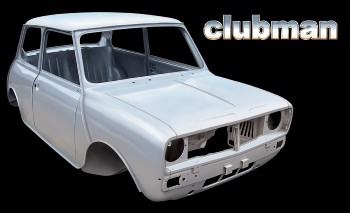 New panels for an old Clubman |
 New panels for an old Clubman |

|
9th July, 2004 Mini Clubman bodyshell joins Heritage range British Motor Heritage Limited, the only company in the world that produces original factory-standard bodyshells for classic cars, has added yet another feather to its cap - the Mini Clubman saloon bodyshell. This new shell is suitable for rebuilding any Mini Clubman saloon or Mini 1275 GT from 1972 to 1980, and is a natural complement to the ‘normal’ original Mini bodyshell successfully launched by Heritage in 2002. Heritage managing director, David Bishop said of the latest major launch : "The main demand for Mini bodyshells is obviously for the original-shape saloon, but we also identified a significant call for bodyshells to repair or rebuild Clubman and 1275GT models. We are now delighted to be able to satisfy another important group of customers in the UK and other markets." While the production tooling for the original Mini body came largely intact from Longbridge after the car finished its phenomenal 41 year run in 2000, the press tools and assembly jigs for the Clubman-style front end hadn’t been used since 1980. Heritage therefore had to finance and instigate a considerable amount of assembly jig commissioning and press tool refurbishment in order to be able to produce the latest bodyshell. Following usual Heritage practice, the Clubman body can be purchased either as a complete shell fitted with doors, bonnet and boot lid, with a recommended VAT inclusive price of £2750, or as a bare shell for £2125. It is built to comply with all original-equipment design and engineering standards, but uses current-technology cathodic electrophoretic coating, seam sealing and oven sealed water-based primer, thus offering better corrosion resistance than was available in the 1970s. As with all Heritage original parts, the Clubman shell is available through the Heritage Approved Mini Specialists. Heritage chairman, Neil Morrick summed up : " The Mini Clubman bodyshell launch gives further proof of our solid commitment to providing genuine parts for Britain’s great classic cars. As thousands of our customers can now vouch, a new Heritage bodyshell is a time-saving and cost-effective approach to a major rebuild project, and gives the best quality result." British Motor Heritage Limited is today a private company. Its roots lie in the Leyland Historic Vehicles group formed in 1975, since when there has been a growing provision of original parts for a wide range of British historic cars, making Heritage the largest organisation of its type in the world. The most radical step taken by Heritage was in 1988, when it launched the complete bodyshell for the MGB tourer. There was simply no precedent for series re-manufacture of bodyshells for cars then up to 26 years old (now 42 years !) and Heritage remains unique in the world in this respect. The bodyshell programme went on to include the MGB GT, the MG Midget/Austin Healey Sprite, the Triumph TR6 and the original Mini, now joined by the Mini Clubman. Heritage also produced all the bodies for the MG RV8. A variety of different specifications of each shell can be produced, so that the total number of derivatives now totals 40, covering the key model and market variations worldwide. British Motor Heritage Limited has a fully-integrated facility in Witney, near Oxford, with a modern 51,500 sq ft (4785 sq m) building incorporating offices, high bay storage and manufacturing facilities. The parts inventory runs to over £2 million, with nearly 10,000 component references. The parts are distributed through an extensive network of Heritage Approved Specialists in the UK and throughout the world. For further information on British Motor Heritage Limited, including a list of Heritage Approved Specialists, see the website www.bmh-ltd.com.
Launched in late 1969, the Clubman range - saloon, estate and 1275GT, was part of the ADO20 Mini facelift programme, which standardised winding windows and internal door hinges on all UK-built Minis except the light commercials. The ADO20 programme was initiated by BMC before the merger with Leyland in 1968, and the design of the ‘square fronted’ Clubman models was carried out under the direction of Roy Haynes, who had moved, with a substantial team, to BMC from Ford, after carrying out the Cortina MkII styling. Many details of the original Clubman exterior and interior design reflected this strong Ford influence. Although rejected by some purist Mini enthusiasts, the upmarket Clubman range made a considerable contribution to the Mini’s most successful sales years. Overall Mini volumes peaked in 1971, with nearly 320,000 built in that year. Total Clubman saloon production from 1969 to 1980 was 331,675, while the 1275GT racked up 117,949 units in the same time. When the 176,688 Clubman estates are added in, the Clubman grand total comes to 626,312. That is quite a substantial portion of the Mini’s 5.4 million, especially since it was only in production for 11 years out of the 41 for which the Issigonis marvel held sway. Successes achieved during those 11 years included first places in class by 1098cc-engined Clubman saloons in the famous Hants. and Berks. Economy Runs of 1977, 1978 and 1979, while at the other end of the spectrum, Richard Longman took his 1275GT to outright victory on the racetracks in the 1978 and 1979 British Saloon Car Championships. Nowadays, in addition to pampered ‘concours’ examples of standard Clubman and 1275GT models at classic car rallies, it is quite common to see the extra underbonnet space of the Clubman used for very high performance engine transplants. However today’s Clubman and 1275GT enthusiasts enjoy their cars, they will be pleased to know that Heritage can now provide them with all the quality body parts they are likely to need, up to and including a complete new bodyshell.
• The Heritage Clubman shell currently available is a direct replacement for Clubman saloon and 1275GT models with rubber mounted subframes, from 1976-80. It can be used for 1972-76 models provided that they are converted to rubber mounted subframes, which are available from Heritage. An alternative Clubman shell is planned which will accept solid-mounted subframes. • 1969-72 models had a different gearshift mechanism and other differences that would require extensive modification to the bodyshell. Mini Clubman/1275GT panels too For Mini Clubman and 1275GT owners who only require individual panels for repair and restoration, Heritage is now also offering the full range of panels that are unique to the Clubman. These join the range of Mini body panels in the established Heritage range, making it possible to replace the most commonly-required sections of a reasonably sound body. As with the complete bodyshell, the panels are supplied in modern factory-standard electrophoretic primer. Heritage can supply a wide selection of other Mini parts, from suspension and brake components to trim items, and has a busy forward programme of new part introductions, all in the interest of keeping Britain’s most famous small car safely on the road for many years to come. |
 Click logo for home page |